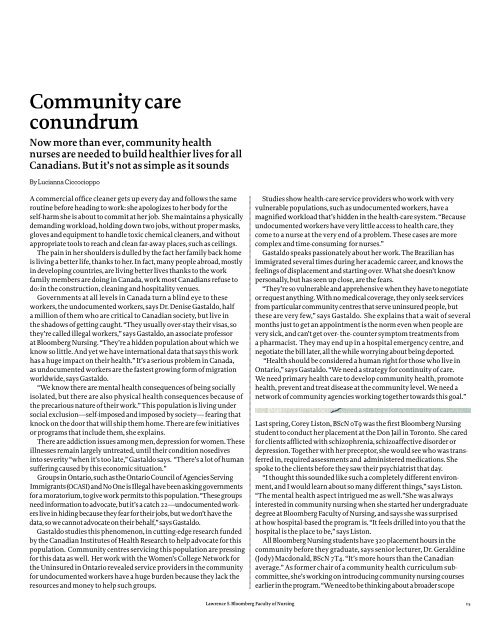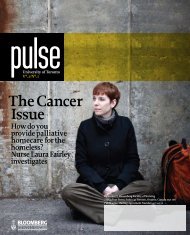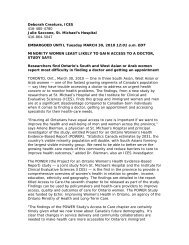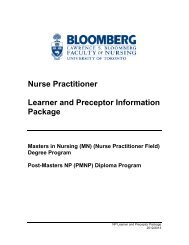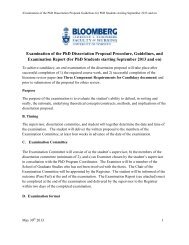Read more - Lawrence S. Bloomberg Faculty of Nursing - University ...
Read more - Lawrence S. Bloomberg Faculty of Nursing - University ...
Read more - Lawrence S. Bloomberg Faculty of Nursing - University ...
Create successful ePaper yourself
Turn your PDF publications into a flip-book with our unique Google optimized e-Paper software.
Community careconundrumNow <strong>more</strong> than ever, community healthnurses are needed to build healthier lives for allCanadians. But it’s not as simple as it soundsBy Lucianna CiccocioppoA commercial <strong>of</strong>fice cleaner gets up every day and follows the sameroutine before heading to work: she apologizes to her body for theself-harm she is about to commit at her job. She maintains a physicallydemanding workload, holding down two jobs, without proper masks,gloves and equipment to handle toxic chemical cleaners, and withoutappropriate tools to reach and clean far-away places, such as ceilings.The pain in her shoulders is dulled by the fact her family back homeis living a better life, thanks to her. In fact, many people abroad, mostlyin developing countries, are living better lives thanks to the workfamily members are doing in Canada, work most Canadians refuse todo: in the construction, cleaning and hospitality venues.Governments at all levels in Canada turn a blind eye to theseworkers, the undocumented workers, says Dr. Denise Gastaldo, halfa million <strong>of</strong> them who are critical to Canadian society, but live inthe shadows <strong>of</strong> getting caught. “They usually over-stay their visas, sothey’re called illegal workers,” says Gastaldo, an associate pr<strong>of</strong>essorat <strong>Bloomberg</strong> <strong>Nursing</strong>. “They’re a hidden population about which weknow so little. And yet we have international data that says this workhas a huge impact on their health.” It’s a serious problem in Canada,as undocumented workers are the fastest growing form <strong>of</strong> migrationworldwide, says Gastaldo.“We know there are mental health consequences <strong>of</strong> being sociallyisolated, but there are also physical health consequences because <strong>of</strong>the precarious nature <strong>of</strong> their work.” This population is living undersocial exclusion—self-imposed and imposed by society— fearing thatknock on the door that will ship them home. There are few initiativesor programs that include them, she explains.There are addiction issues among men, depression for women. Theseillnesses remain largely untreated, until their condition nosedivesinto severity “when it’s too late,” Gastaldo says. “There’s a lot <strong>of</strong> humansuffering caused by this economic situation.”Groups in Ontario, such as the Ontario Council <strong>of</strong> Agencies ServingImmigrants (OCASI) and No One is Illegal have been asking governmentsfor a moratorium, to give work permits to this population. “These groupsneed information to advocate, but it’s a catch 22—undocumented workerslive in hiding because they fear for their jobs, but we don’t have thedata, so we cannot advocate on their behalf,” says Gastaldo.Gastaldo studies this phenomenon, in cutting-edge research fundedby the Canadian Institutes <strong>of</strong> Health Research to help advocate for thispopulation. Community centres servicing this population are pressingfor this data as well. Her work with the Women’s College Network forthe Uninsured in Ontario revealed service providers in the communityfor undocumented workers have a huge burden because they lack theresources and money to help such groups.Studies show health-care service providers who work with veryvulnerable populations, such as undocumented workers, have amagnified workload that’s hidden in the health-care system. “Becauseundocumented workers have very little access to health care, theycome to a nurse at the very end <strong>of</strong> a problem. These cases are <strong>more</strong>complex and time-consuming for nurses.”Gastaldo speaks passionately about her work. The Brazilian hasimmigrated several times during her academic career, and knows thefeelings <strong>of</strong> displacement and starting over. What she doesn’t knowpersonally, but has seen up close, are the fears.“They’re so vulnerable and apprehensive when they have to negotiateor request anything. With no medical coverage, they only seek servicesfrom particular community centres that serve uninsured people, butthese are very few,” says Gastaldo. She explains that a wait <strong>of</strong> severalmonths just to get an appointment is the norm even when people arevery sick, and can’t get over- the- counter symptom treatments froma pharmacist. They may end up in a hospital emergency centre, andnegotiate the bill later, all the while worrying about being deported.“Health should be considered a human right for those who live inOntario,” says Gastaldo. “We need a strategy for continuity <strong>of</strong> care.We need primary health care to develop community health, promotehealth, prevent and treat disease at the community level. We need anetwork <strong>of</strong> community agencies working together towards this goal.”Last spring, Corey Liston, BScN 0T9 was the first <strong>Bloomberg</strong> <strong>Nursing</strong>student to conduct her placement at the Don Jail in Toronto. She caredfor clients afflicted with schizophrenia, schizoaffective disorder ordepression. Together with her preceptor, she would see who was transferredin, required assessments and administered medications. Shespoke to the clients before they saw their psychiatrist that day.“I thought this sounded like such a completely different environment,and I would learn about so many different things,” says Liston.“The mental health aspect intrigued me as well.”She was alwaysinterested in community nursing when she started her undergraduatedegree at <strong>Bloomberg</strong> <strong>Faculty</strong> <strong>of</strong> <strong>Nursing</strong>, and says she was surprisedat how hospital-based the program is. “It feels drilled into you that thehospital is the place to be,” says Liston.All <strong>Bloomberg</strong> <strong>Nursing</strong> students have 320 placement hours in thecommunity before they graduate, says senior lecturer, Dr. Geraldine(Jody) Macdonald, BScN 7T4. “It’s <strong>more</strong> hours than the Canadianaverage.” As former chair <strong>of</strong> a community health curriculum subcommittee,she’s working on introducing community nursing coursesearlier in the program. “We need to be thinking about a broader scope<strong>Lawrence</strong> S. <strong>Bloomberg</strong> <strong>Faculty</strong> <strong>of</strong> <strong>Nursing</strong> 15


